Foxconn WinFast 6150K8MA – 8EKRS
Oct 21st, 2005 | By Archive
Foxconn WinFast 6150K8MA – 8EKRS
Date
: 10/21/05 – 02:08:01 AM
Author
:
Category
: Motherboard
Page 1 : Index
Foxconn WinFast 6150K8MA-8EKRS
Manufacturer:
Foxconn (Hon Hai Precision Industry Co., Ltd)
Price:
$75USD MSRP
It didn't take long for Foxconn to return to us here at Overclockers Online. After reviewing their WinFast NF4SK8AA-8EKRS a little over a month ago, I was more than willing to tackle another offering from the Taiwan based company that is jumping into the retail market with a vengeance after being primarily known as an OEM producer for quality components. Foxconn's international presence is heavy and this global leader doesn't appear to be satisfied with its current position introducing model after model in their WinFast line-up of motherboards. More is better!

Today, we will get a look at one of the newest motherboards Foxconn is producing and one that is breaking new ground in the motherboard market. The WinFast 6150K8MA-8EKRS is a micro-ATX based motherboard sporting NVIDIAs GeForce 6 6150 onboard video in addition to the PCI-Express x16 graphics slot. This combination is brand new and Foxconn is one of the first to get this chipset to store shelves. I was very impressed with the last Foxconn motherboard I looked at and am very much looking forward to this one.
Page 2 : Package & Contents
I don't know what it is about getting motherboards that gets me so excited. I mentioned in other reviews that I think it is because there is just so much to investigate and tinker with but after my last experience with Foxconn I know my excitement is partially from my eagerness to get to overclocking this new chipset.

If you read my WinFast NF4SK8AA-8EKRS review then you will no doubt recognize this box. It is identical aside from the model number printed on the front. The more I see this design the more I like it because of its simplicity and clean elegance. You will notice that Foxconn is not visible anywhere on the box. This is because Foxconn uses the WinFast name for their AMD based motherboards.

The majority of the back panel is reserved for Foxconns proprietary software with the bottom strip used to display the multitude of logos describing the features of the motherboard contained inside.



The only list of specifications on the package are listed here on this sticker in the lower right hand corner on the front edge of the box.

When we open the box, we are greeted with a driver CD and the quick install poster that provides an excellent reference for installing the various connections on the motherboard.

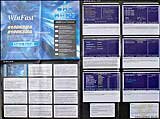

With the poster and CD removed, I realized I did not receive a manual with this motherboard. I believe this is because I received this motherboard before it hit mass production and thus, the manual was not quite ready. I have downloaded the PDF manual from the web site already though. At first glance, it does not appear to be a very rich set of packaged accessories and cables.

Secured firmly at the bottom of the box is the motherboard itself, in its protective anti-static bag. We can already see the bright orange PCB that Foxconn is becoming known for in computer forums that I frequent. I like the orange and it seems that I am not alone as many people have commented on the unique color.

Now that I have spread out the contents of the package, my suspicions are correct that the included accessories are somewhat lacking. The 6150K8MA-8EKRS comes with a floppy and single ATA ribbon cables, one SATA cable, and a 4-Pin > 2xSATA power cable converter. We are also supplied with a single RAID driver floppy disk and the CD that contains the rest of the drivers and WinFast utilities. The bracket on the left is the S-Video out connection for the onboard 6150 video. Last but not least is the rear I/O panel.
It is time now to take a look at the specifications and features of this new hybrid chipset.
Page 3 : Specifications & Features
As outlined on the Foxconn web site, here is the list of specifications that are the genetic makeup for the 6150K8MA-8EKRS:
AMD Athlon 64/Athlon 64 FX/Athlon 64 X2 Dual-Core, Socket 939 (939-pin), 1600/2000MT/s
Chipset
NVIDIA® GeForce 6150 GPU + nForce 430 MCP
Memory
Dual channel, unbuffered, 2.5V DDR266/333/400, (4) 184-pin DIMM sockets, max 4GB
Graphics
Integrated NVIDIA high-performance graphics controller (fast core) plus PCIe x16 slot
PureVideo CE-quality video processor
Supports up to 128MB shared system memory – virtualized up to 256MB
Expansion Slots
1 x PCI Express x16, 3 x PCI
IDE/ATA Support
2 x ATA/133 + 4 x SATA/300 (w/ RAID)
Supports RAID 0, 1, 0+1, and 5
Audio
Integrated, 7.1 channel AC97 (Realtek)
LAN
Integrated Gigabit Ethernet (10/100/1000) MAC + PHY (Marvell)
IEEE-1394
2; 1 x 6-pin in rear I/O area + 1 front via internal header; 1394a (TI)
USB
Up to 8; 4 in rear I/O area + 2 internal 2-port headers; ver. 2.0
Rear I/O Ports
1 x PS/2 keyboard
1 x PS/2 mouse
1 x RJ45 (LAN)
4 x USB 2.0
1 x line-in/line-out/mic (audio)
1 x parallel (SPP/ECP/EPP)
1 x COM (16550-compatible UART)
1 x VGA (integrated video)
Additional line-outs for 7.1 channel audio
1 x IEEE-1394
TV-out via cable/bracket
Internal Connectors/Headers
1 x floppy disk drive
Front audio header
2 x USB 2-port headers, ver. 2.0
BIOS
4Mb flash EEPROM w/ LAN boot, PnP, ACPI, WfM, DMI 2.0,
Special Features
Wake-on-LAN (WOL), suspend-to-RAM (STR, S3), suspend-to-disk (STD, S4), SuperUtilities – SuperBoot, SuperBIOS-Protect, SuperRecovery, SuperSpeed, SuperStep, SuperLogo, and SuperUpdate; NVIDIA ActiveArmor, Firewall, MediaShield, and nTune
Overclocking Features
Adjustable bus speeds
Adjustable memory timing
Adjustable voltages (may be Vcore only)
Accessories
Support CD, user's manual (on CD), rear I/O shield, 1 x floppy drive cable, 1 x HDD/ODD drive cable (supports UDMA/ATA 33/66/100/133 drives)
Quick installation poster
RAID driver on floppy disk(s)
1 x SATA data cable, 1 x SATA power cable (supports 2 drives)
TV-out cable/bracket
Processor heat sink retention mechanism
Form Factor
microATX, 9.6'' x 9.6'' or smaller – see User's Manual

With a press release, this is how Foxconn introduced the WinFast 6150K8MA-8EKRS to the world at the end of September of this year:

Here is the limited amount of information I could dig up on this new
GeForce 6150/ nForce 430
chipset combo and some of what it offers vs the
GeForce 6100 / nForce 400
chipset:



Page 4 : Layout
With this being a brand new chipset, I will definitely be using this layout overview as a tool to learn it myself, lets see what Foxconn has put together with their offering of the 6150/430 chipset.

We start the layout section with a look at the entire motherboard. Another beautifully bright orange PCB greets us at the door. I think Foxconn has made a bold and great decision to go with this color on a number of their motherboards. It sure beats the bland yellow of the others they produce.

The CPU socket is gapped nicely from the surrounding components and seems to have a little more space between it and the memory DIMMs than the NF4SK8AA-8EKRS. Although, this will generally not be an issue seeing as the main role of this board will be in HTPC cases or for general lower end PC use. This equates to very few of these boards actually seeing big gangly CPU coolers and the stock AMD64 heatsink/fan will likely get the most airtime on this motherboard. That said, the capacitors near the one edge of the socket are the same as the other Foxconn motherboard I reviewed and they did not interfere with a few of the CPU coolers I have mounted on it.

The 3-Phase power center is tucked in-between the CPU and the I/O panel, as it is on most all socket 939 motherboards. Again, Foxconn is not relying on a heatsink to cool the row of MOSFETs but the location alone leads to some cooling by way of the air being forced out of the side of a stock AMD64 HS/F and out the rear exhaust fan which runs over the MOSFETs on the way. Foxconn has moved the 4-pin auxiliary power connector from the top of the board down to the more standard location in the middle of the motherboard below the CPU socket.

The memory DIMM sockets show space for four modules supporting up to 4GBs of RAM. There is nothing really to note about the location except that the ends toward the middle of the board are very close, geographically, to the PCI-E x16 connection. The backside of video cards are not bulky in anyway, so it should not interfere with even a long card but I will keep my eye on this during installation.

The location of the 24-pin ATX power connection, IDE connections and floppy connection provide a favorable setup for a clean cable installation sitting right on the leading edge of the motherboard.

Foxconn has gone with an ITE IT8712F-A system monitoring chip for the 6150K8MA-8EKRS instead of the Winbond found on previous motherboards of theirs. I have not had any experience directly with this chip, but it is fairly common so I am sure SpeedFan and the like will not have a problem drawing accurate data from it.

The location of the battery is bit odd being up here when the CMOS clear jumper and BIOS chip are down in the front corner, but when you are jamming this much technology onto a tiny little PCB like this, you just mount stuff like this where it fits.

As we work our way down to the bottom front corner, we come across the passively cooled Southbridge. The 430 Southbridge is responsible for the ATA, SATA, high-definition audio, Gigabit Ethernet, USB 2.0 ports, and RAID functions of the system. It handles a lot and that is why it has so many friends hanging around its corner.

As I was saying, everyone wants to be near the Southbridge. Up the right side are our four SATA connections and in the corner is the BIOS and clear CMOS jumper. Along the bottom edge, going from the front to back, are the front panel connections followed by the two additional USB connections.

Moving along the bottom edge we run into the 1394 connection, a speaker connection and the onboard speaker. Just above these is the Texas Instruments TSB43AB22A chip that provides function to the Firewire connection.

In the opposite corner we run into audio central. The jumpers for dictating the audio output are located here alongside the CD audio in connection and SPID out. The audio is handled by Realteks 8-channel ALC850 chip hiding out behind a couple capacitors. I won't go over the specifications here but you can find out everything you might want to know about this multimedia IC here.
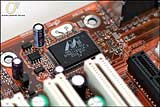

The expansion slots on the 6150K8MA-8EKRS are not abundant but they provide anything and everything you might want out of a motherboard of this nature. Three PCI expansion slots accompany the x16 PCI-E slot seen here dressed in black. The GeForce 6150 Northbridge is located just north of these slots and is cooled passively like the Southbridge.

The backside has nothing fancy going on, much like the backside of most any other motherboard. The CPU retaining bracket backplate is a nice and hefty unit providing plenty of support for the heatsink and fan on the opposite size.

The rear I/O panel has the standard connections including PS/2 mouse and keyboard connections, a parallel port, COM port, four USB connections, a 1394 FireWire and LAN connection plus the audio connections. If you were paying close attention to the specifications, you will have noticed that the GeForce 6150/NVIDIA 430 chipset allows for dual display capability with a VGA output and a DVI output. Foxconn has omitted the DVI output and offered just the VGA connection for the native GeForce 6150 that is on-board. This is a bit of a setback as this type of motherboard would be perfect for an HTPC application which would dearly benefit from a DVI output.
Page 5 : Installation
I anticipate the installation of the WinFast 6150K8MA-8EKRS to go rather smoothly. I am putting this micro-ATX motherboard in a fairly large and easily accessible case. If your intentions are to install this motherboard in a SFF case to be used as an HTPC, then your job will be a little tougher than mine. Either way, you just want to use care and attention throughout the process.
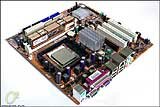
The first step involves mounting the CPU in the socket and I usually install my memory modules at the same time as I have done so here. There were no issues with the socket and the CPU dropped right into place and locked down with ease.
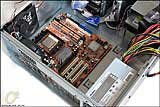
I then figured I would test fit the motherboard to make sure the case would be able to mount the micro-ATX board without issue. Everything seems to fit fine and there is plenty of room to breathe in there. I will note that the two mounting holes on the bottom right corner of the motherboard was not secured as the Antec Take 4 case does not have holes there for standoffs. This will not be an issue, so no concern there.
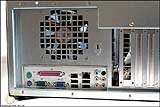
Having installed the rear I/O first, we can see that everything fits perfectly, nice and snug. Also, if you look just to the right I have removed the two PCI expansion slot covers which the video card will be using and the PCI-E slot appears to line up exactly where we want it to. With everything looking like this case will be a good fit for the 6150K8MA-8EKRS it is time to pull it out and mount the CPU. Now I could just mount it in the case but I need to get you some photos.

As you can see, the CPU cooler I am using does not come close to any of the surrounding motherboard components. The RAM slots are far enough away to give plenty of room for even a larger cooler and the capacitors peeking over the Northbridge cooler are no where near tall enough to interfere with the CPU cooler.

As I noted earlier in the layout section, the PCI-E x16 slot is quite tight with the ends of the RAM DIMMs. Seen here, they clearly don't interfere but I could not remove the RAM without removing the video card. This normally won't be a big issue but you will want to make sure you install the RAM before the video card to save yourself some hassle.

Even with the HIS X800GTOs massive cooler, the second PCI expansion slot is still useable which means there is plenty of room given to the x16 PCI-E slot above it. With everything test fitted and looking good I can now mount the motherboard and components into the case and begin connecting cables.

The provided poster outlines all cable connections but you will have noticed that the PCB comes printed with descriptions of all the connections anyway so the process is quite painless. I will mention that I really like Foxconns choice of SATA connections on this motherboard. They actually seem to secure the cables quite well, un-like some motherboards I have had. I have managed to keep the cables fairly tidy so that plenty of air will be bale to go over the passive heatsinks and keep everything nice and cool, time to power up.
Page 6 : BIOS

To get to the BIOS is no different than any other motherboard, press DEL at the POST screen. Foxconn is using a Phoenix Award Workstation BIOS and the POST screen provides us with the amount, speed, and timings of the current memory settings.

This is a very straight forward and easy to navigate BIOS with a couple of columns worth of options, so we'll start at the top on the left hand side.
Standard CMOS Features

BIOS Features

This is where all but the memory overclocking settings will be adjusted using, what Foxconn refers to as, the SuperSpeed section. You can see the options to enable the proprietary features described on the box are also in this section.
SuperSpeed

Once in the SuperSpeed section, we see that we will have the ability to adjust the main options for overclocking with the main adjustment, the HTT, hiding in the Performance Options section.

The HTT can be raised up to 300 in 1MHz increments. The PCI-E can also be adjusted here. Since we don't have PCI Bus frequency adjustment, I think it is safe to assume that is locked at 33MHz already.

Back in the SuperSpeed section, we see the Hammer Fid Control is actually the CPU multiplier and we are only giving the ability to adjust by full multiples down to 4 and not half multiples like most. This really won't affect the overclocking anyway.
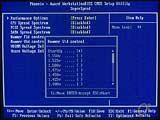
The Hammer Vid control is for adjusting the Vcore voltage and goes up to 1.550v.

The VDIMM Voltage is limited to a range of 2.50v – 2.85v which is pretty standard for most motherboards these days. One day all motherboards will offer up to 3.30v for memory but by then we will be running DDR2 memory and high voltage requirements for tight memory timings will be a thing of the past.

The last option seen here gives us the ability to add even more voltage to the CPU with a theoretical ability to provide as much as 1.69v in combination with the 1.55v in the Hammer Vid control.
Advanced BIOS Features

A whole host of options is available for adjusting here, but mostly, this section will be used to determine your boot order and devices for booting to.
Advanced Chipset Features
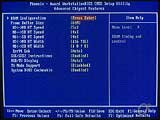
Here is where we can get to out memory adjustments as well as the HyperTransport multiplier select. You can see there are actually three different multipliers for the various paths of HyperTransport in-between the CPU, NB, and SB.
DRAM Configuration
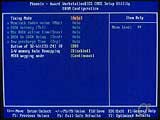
This section will obviously be the spot to adjust timings and frequency of the RAM. Note the lack of an adjustment for 1T/2T choice. The system will be determining on its own which command rate the memory will be using. The memory dividers that are offered are your basic 200 / 166 / 133 / 100 that are present on most motherboards.
Integrated Peripherals

In the Integrated Peripherals section we will have a quick look at the IDE Function section.
IDE Function Setup

This is the home to all the hard drive selection options to enable or disable SATA controllers and IDE controllers. This is also where we would have to enable the RAID function had my WD Raptor not recently gone to hard drive heaven.
Power Management Setup

PnP/PCI Configurations
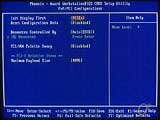
If you are going to be running the onboard video, you will want to set the Init Display First to onboard otherwise your screen will be blank as the default is PCIEx.
PC Health Status

Foxconn has improved on this section since the NF4SK8AA-8EKRS as there is a lot more information provided to us here. The CPUFAN SmartFAN Control is a neat feature. It allows for fan control of the CPU fan header on the motherboard. This means no additional program like SpeedFan or a fan control will be required to keep the CPU fans noise in check when it is not required. I tested it out by setting the Start temp to 35 and the PWM Full on temp to 45. The CPU fan on the VapoChill Micro Ultra Low-Noise was held at 800RPM until the temperature of the CPU reached 45C. At that point the fan was kicked up to the high speed of 2300RPM. All of this was in Windows with no drivers or additional software needed. I think this is just perfect for a motherboard of this nature.
Page 7 : Overclocking
Even though this is a micro-ATX motherboard and that it has on board video so its main audience won't be the overclocking or gaming enthusiasts, it doesn't mean that we will skip on testing the overclocking abilities of this motherboard. I know when I put my HTPC together, I will want the most performance out of it and this will mean overclocking so let's see what we can squeeze out of the WinFast 6150K8MA-8EKRS.
I will be approaching this overclock as I do all other motherboards. I will start by retarding the frequency of the CPU/RAM/and HT then increase the HTT to find the maximum it can handle. From there it will just be a matter of bringing the other three components in-line using the same method. The BIOS provides ample tools to achieve a solid overclock and with my last Foxconn motherboard having overclocked extremely well, my expectation is high for this one.

The chart above outlines what I was able to achieve and at what settings were required to get there. At 6*276 the system would not POST and would default into safe mode. I increased the Vcore in steps and lowered the rest of the settings with no luck. It appears the maximum HTT that this motherboard can achieve with the current BIOS is 275. That is not to shabby at all and should be just enough to maximize the components used for testing. I ran the system for an hour at 100% load using Prime95 in torture test blend mode at each stage and then 12 hours for the last line of the chart to ensure a legitimate and stable overclock.
Next up on the overclocking block with be to use that range of 200-275HTT to find the maximum CPU frequency. Keep an eye on the voltage in the chart below as I will be increasing that to help achieve the maximum overclock.

At 266*9 the system would POST 100% of the time and had no problems running in windows that I could find, no lock-ups or random reboots. Prime95, however would error out within ten minutes. The final overclock of 265*9 was ran for 6 hours in Prime 95 to ensure that the CPU overclock would be 100% stable at these voltages. Normally the highest this particular 3000+ Winchester will run is 275*9 with 1.65v and the motherboard was capable of supplying 1.65v to the Vcore so the CPU was not the limiting factor in the overclock but still a very good one of this CPU.
The last of the individual overclocks will be to determine how high we can the HT with the 6150K8MA-8EKRS which will dictate whether we use a multiple of 4 or if we have to drop it to 3 to run the maximum HTT and CPU speeds we could find.

This is quite interesting that the HT could run as fast as it shows in the chart. I double checked in Everest to make sure that the BIOS was registering the values I set in the BIOS and it showed up in Everest as 1300MHz so it's clear that for some reason the HT on a multiple of 5 was not causing instability of any kind. The HT running this fast has no gains shown by benchmarks so I will be using a multiple of 4 just to make sure I don't hurt anything.
Normally, the RAM would also be included in finding its maximum overclock but the modules I will be using for testing have been around the block a few times and the maximum they can run in every system tested thus far is 223MHz so that value will be used in the determination of our final overclock. I will note that the motherboard was fun to work with because I never once had to reset the CMOS or even use the reset button on the machine. When a component was pushed to far and the system would not POST, all I had to do was wait about 5 seconds and the system would reboot on its own with safe settings to allow you to get into the BIOS and try again. I have not had a motherboard help out this much before in overclocking. Here is the final overclock I decided on based on the values above:
- CPU – 9*265 = 2385MHz on 1.64v
- RAM – 217MHz (CPU/11) for an effective 442MHz at 2.5-3-3-7 1T on 2.7v
- NB > CPU HyperTransport – 265*4 = 1060MHz / SB > NB HyperTransport – 265*4 = 1060MHz / NB > SB HyperTransport – 265*4 = 1060MHz
I am impressed with what this little guy was able to achieve. The combination of the GeForce 6150 and NVIDIA 430 chipsets seems to be quite the capable overclocker. This overclock was run in Prime95 on torture test blend for 24 hours straight and proved to be 100% stable.
Page 8 : System BenchmarksFor the benchmarks I will be running the following system:
Control:The benchmarks used will be my standard set of programs used to test the overall performance of a system. PCMark 04 and 05 will be ran on default settings to get an overall score of the ability of the system in a variety of tests using real world applications of everyday computer use including audio conversion, WMV video conversion, and web page rendering among others. PCMark 05 takes the system test to another level incorporating multiple multithreaded test as well as HD general usage and some graphics tests. I will also be running all systems through the popular SuperPi to see how the pure number crunching power of each motherboard stand sup to each other. HD Tach will be run for both SATA and IDE drive performance. Science Mark v2.0 will be utilized for its Molecular Dynamics and Primordia tests as well as its memory bandwidth test. Everest Ultimate will also be run for memory bandwidth along with SiSoft Sandra Pro 05 and its host of other tests. Lets get to the results…
3000+ AMD64 Winchester
VapoChill Micro CPU cooler Ultra Low Noise
Sapphire X700Pro 256MB
2 x 512 OCZ PC3200 Premier Dual Channel
WD Raptor 10,000RPM 36.7GB
Antec TruePower 420W
Windows XP (32-bit Edition) SP2 + Latest Drivers
Antec Take 4 rackmount caseMotherboards:
Foxconn WinFast 6150K8MA-8EKRS
Foxconn WinFast NF4SK8AA-8EKRS
Asus A8V-E Deluxe K8T890 / VT8237PCMark 04/05
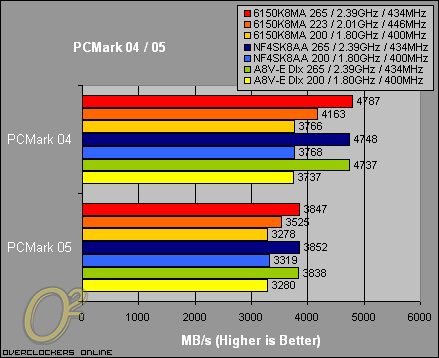
Super Pi 1 Million, 2 Million, and 32 Million Digits

The slightly weaker performance on the NF4SK8AA-8EKRS is due to the fact that I cannot get any RAM to run in 1T mode on that motherboard. With both the 6150K8MA-8EKRS and A8V-E Deluxe running at 1T command rates, they are pretty much even all the way through.
Science Mark v2.0
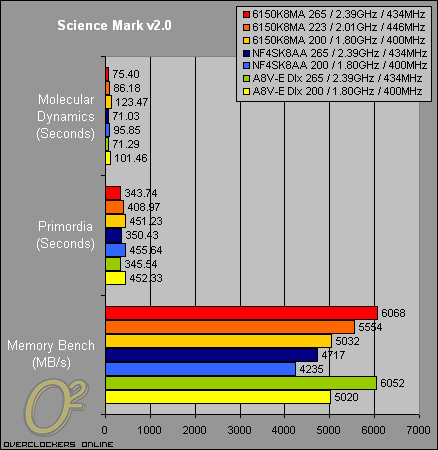
Here again the 6150K8MA-8EKRS is equal to the Asus board being the two running at 1T. I wish I had the ability for the other nForce 4 motherboard to run at 1T but based on these results, I am sure the two nForce 4 boards would be very equal.
SiSoft Sandra Pro 2005 CPU Arithmetic
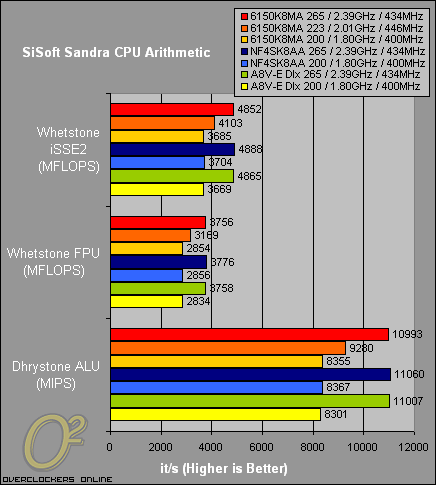 Another neck and neck battle amongst the contenders.
Another neck and neck battle amongst the contenders.SiSoft Sandra Pro 2005 CPU Multimedia
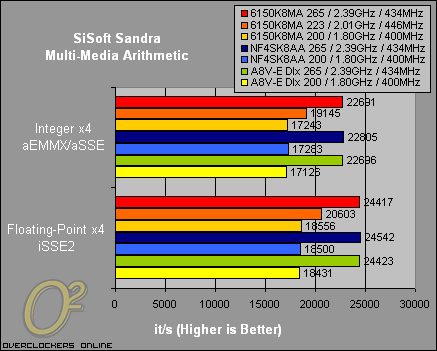
SiSoft Sandra Pro 2005 Memory
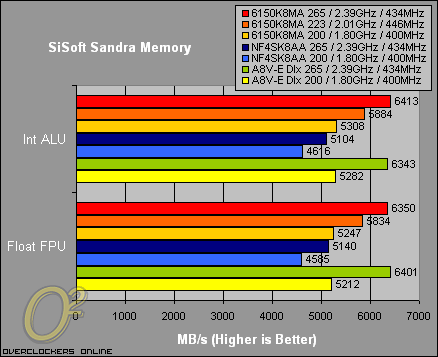
Everest Ultimate Memory Benchmark
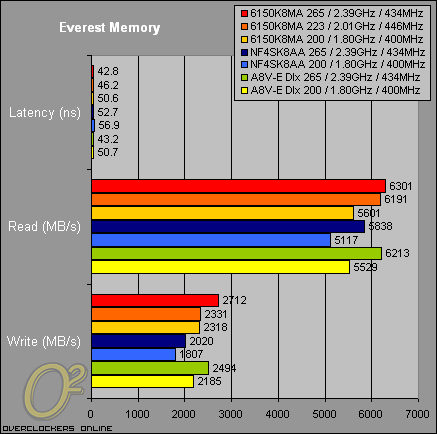 More of the same as the other memory benchmarks, but the little 6150K8MA-8EKRS actually shows a noticeable increase in Write performance and a slight lead in read performance.
More of the same as the other memory benchmarks, but the little 6150K8MA-8EKRS actually shows a noticeable increase in Write performance and a slight lead in read performance.HD Tach v3.0.1.0
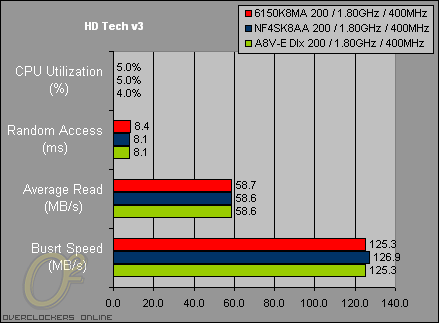
I would have loved to include results from the RAID performance in conjunction with the regular SATA results but one of my WD Raptors conveniently perished just after receiving this motherboard and I am still waiting for the replacement. The above results are just a single WD Raptor and show almost identical performance with the regular nForce 4 controller as well as the VIA VT8237 controller.
Page 9 : PCI-E Gaming BenchmarksFor gaming performance, I did not overclock as I was having issues getting the 6150K8MA-8EKRS to run the benchmarks while being overclocked with using the on-board 6150 although there was no issues running the benchmarks overclocked using the Sapphire X700Pro. The issue is likely due to the BETA drivers being used for the on-board video. I decided on four games to run and 3DMark 01se / 03 / 05. The games were ran using BenchEmAll on maximum settings and include Doom III, Far Cry, Half-Life 2, and Unreal Tournament 04. The 3DMark benchmarks were ran manually with the default settings. Let's see how the 6150K8MA-8EKRS matches up against a couple bigger motherboards.
3DMark 01se / 03 / 05

There is absolutely no discernable difference between the results of the three motherboards with the X700Pro tucked into the X16 PCI-E slot but of course the integrated graphics of the 6150 are severely lacking in 3d performance. It appears the 6150/430 chipset will have no problem performing just as well as the regular nForce 4 chipset in gaming performance which is a welcome sign.
Doom III

Far Cry

Half-Life 2

Unreal Tournament 04

Throughout all the gaming benchmarks, it is pretty much a draw amongst the three motherboards thus cementing my earlier statement that the 6150/430 really is capable in competing in the graphics arena with the two other mainstream chipsets. This will definitely raise its stock value as the word spreads that you will not be losing any performance with this package. Of course, the integrated 6150 graphics are not capable of handling the more demanding games such as Doom III, Far Cry, or Half-Life 2, but that is to be expected as the onboard graphics really will only be used for 2D applications and multimedia programs.
Page 10 : ConclusionI think the benchmark and overclocking results speak for themselves, the Foxconn WinFast 6150K8MA-8EKRS packs a lot of punch into a tiny little package. It competes with its big brother the NF4SK8AA-8EKRS which sports the nForce 4 SLI chipset and actually seems to have the upper hand with the ability to run RAM at 1T command rate. In the system benchmarks, there were no gaps between the 6150K8MA-8EKRS and the Asus motherboard and that similarity carried over to the gaming benchmarks to test the 3D graphics performance.
As for the 6150/430 chipset combination, I believe we have found an NVIDIA answer to the earlier released Radeon Xpress 200 from ATI. The features this chipset offers are remarkable and really suit the HTPC market quite well. Foxconn however has not chosen to use all the features and this hurts the 6150K8MA-8EKRS a little bit. The lack of DVI monitor and component video outputs does take away from some of the shine that was put on this motherboard by the performance it offers. HDTV is here to stay and a great many people have already made the switch over with expensive HDTV purchases. These same people are likely the ones that will be looking for an HTPC that can utilize that brand new HDTV. With only an S-Video output on the 6150K8MA-8EKRS, that will not be possible. The HDTV ability on the computer monitor is fantastic but having the ability to project that beautiful picture to a 50" HDTV would be even more fantastic.
With that said, I don't think we can hide from the fact that this is one heck of a solid package in the price range it is being offered. Foxconn has once again put a smile on my face with the overclocking options and performance out of the Micro-ATX WinFast 6150K8MAA-8EKRS and I think it is an exceptional offering in what is sure to become a very competitive market.
Advantages:
- Equal performance to recognized chipsets
- The NVIDIA 6150/ nForce 430 chipset is loaded with amazing features
- Overclocking this motherboard is quite possible
- Quiet as a mouse with passive chipset cooling
Disadvantages:
- No DVI output
- No component Video output
Overclockers Online would like to thank Foxconn for supplying the WinFast 6150K8MA-8EKRS for this review.
Foxconn has been kind enough to support our birthday contest, so don't forget to check it out here.